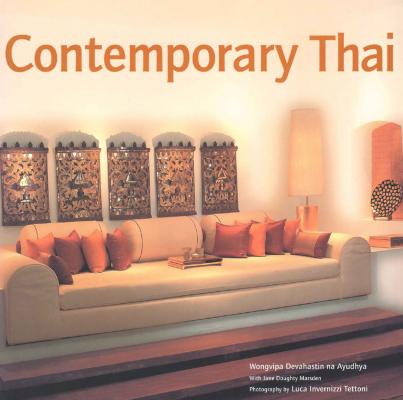Contemporary Thai. Wongvipa Devahastin Na Ayudhya
Читать онлайн.| Название | Contemporary Thai |
|---|---|
| Автор произведения | Wongvipa Devahastin Na Ayudhya |
| Жанр | Книги о Путешествиях |
| Серия | |
| Издательство | Книги о Путешествиях |
| Год выпуска | 0 |
| isbn | 9781462906888 |
This teakwood cabinet from AKA, Bangkok, has the tapered form typical of traditional northern-style furniture and houses, yet has a timeless quality suitable for modern interiors.
The lowdown on the latest teak coffee-tables by Prinya for Jim Thompson:
Paired with Thai silk cushions from Jim Thompson, this table is perfect for relaxing in the Oriental style.
This version has distinctively Thai curved legs.
Wicker insets- a la the current mode of finishing antique daybeds from China-are light and fashionable.
Architect and AKA furniture designer Eakrit Praditsuwana calls his signature style "neo-romantic functionalism". All of his pieces salute Thailand's rich heritage, and he is particularly influenced by the work at Wat Prathat Lampang Luang. Hand-woven, easy-care fabrics such as cotton in neutral colours, shown here, complement contemporary shapes in teak. The screen print on mulberry paper inspired by a temple mural and the Earth & Fire ceramic tea set are also designed by Eakrit.
Gin and tonic, anyone? The deckchair, once de rigueur on the verandahs of expatriate homes in Southeast Asia, gains a new lease of life with upholstery in thick Thai cotton. An ornate Dutch colonial lamp adds to the nostalgic feel. A Lanna vase and offering trays rest on a manuscript cabinet-reconstructed and decorated with Lanna-style lacquered patterns.
Second-hand Splendour
Recycled pieces—especially given today's concern over diminishing natural resources such as wood-are aesthetically pleasing, supremely functional and politically correct. Whole villages in Thailand, such as Hang Dong just outside of Chiang Mai, are now devoted to turning temple brackets into table bases and manuscript cabinets into cupboards-with the same levels of craftsmanship and labour that went into making the original objects. Indeed, it is precisely the demand for recycled pieces that keeps many of these traditional crafts (and craftsmen) alive.
Humour and homage combine in some of the best recycled elements: a soldier's helmet does duty as a lamp stand; a reconstructed xylophone-like song mon, traditionally used at funerals, summons hotel guests to dinner; a bedside-lamp base in a honeymoon suite utilises wood from a temple pillar; cabinets which once held precious scriptures now conceal television sets.
In the open-air reception sala at Baan Suan restaurant, Chiang Mai (pictured right) four scroll-shaped eave brackets from an old temple make an attractive table base. Other recycled elements include a gilded Lanna-style temple gable, now an eye-catching wall feature, and a cupboard constructed from panels of old lacquered manuscript cabinets.
Modern incarnations of utilitarian or even religious items are limited only by the imagination of the eventual owner.
The open-air reception sala at Baan Suan Restaurant, Chiang Mai.
Homespun cotton cushions add warmth to this family room. The chest, which serves as both coffee-table and storage space, is from recycled wood, as is the mirror frame.
A pair of comfortable art deco-inspired armchairs assembled from old teak complement a console of old manuscript cabinet pieces at Baan Suan.
Mirror mirror on the wall. At the Lanna Spa, wooden side panels of a Burmese xylophone inlaid with mirrors, make a stunning backdrop to this oversized sofa upholstered in Thai cotton and designed by Lek Bunnag.
The Art of
Thai Accents
While traditional high-end Thai style was a riot of saturated colours and intricate designs, today's approach follows the global trend of accent rather than the complete vernacular. Subtle nuances are often more attractive to people of other cultures and feasible for most homes. From the simple touch of a lotus seed-pod on a coffee-table to the extravagance of a nautilus-shell caviar spoon inlaid with scarab beetles' wings and rubies, Siamese suggestions whisper romance and wonder. Think of the seductive curves of a mangowood lampbase a la Elle Macpherson's Bahamas beach house, the glint of gold on a glossy black-lacquered plate, or flowers in an imposing bamboo-and-bark basket formerly used to hold sticky rice. Now your guests are talking.
Contemporary geometric designs on these plates by Living Space, Chiang Mai, at the Lanna Spa further the appeal of this classical craft.
Gold-lacquered trinket boxes, which inspired this modern version from Living Space, were donated to temples to earn merit.
Post-massage pampering; lemongrass tea in celadon on a gold-lacquered tray (Living Space).
Gold Rush
One of the most elegant and exacting of Thailand's ancient crafts, gold and black lacquer painting requires at least 17 steps and 90 days to complete.
Lai rod nam ("ornaments washed with water") involves applying several coats of natural lacquer resin to wood, pottery or spun bamboo. Each layer is allowed to dry-a process which itself may take 15 to 20 days-and then polished with sandpaper and the bare human hand, the oil of which gives a wonderful sheen. A design is then painted on the piece, to which many layers of gold leaf are added (the background is covered with white latex). Each piece is then dipped in water to wash away the background, leaving behind brilliant 24k gold motifs.
In the late 18th century after Bangkok became the Thai capital, lai rod nam graced palace and temple pillars, window panels, screens, doors, ceremonial bowls, boxes and Buddhist scripture cabinets. Floral and vegetal patterns as well as mythical Buddhist creatures and scenes from the Ramakian, the Thai version of an Indian epic, were the most popular designs.
Today, contemporary designs are produced by Chiang Mai-based company Living Space. Even though it draws on traditional Thai and Japanese techniques, the lavish ornamentation is pared down to produce more spare, simpler items. Company designer Jennifer Dyson says: "My philosophy with Living Space is to develop and promote top-quality Asian crafts with a Western slant."
Конец ознакомительного фрагмента.
Текст предоставлен ООО «ЛитРес».
Прочитайте
